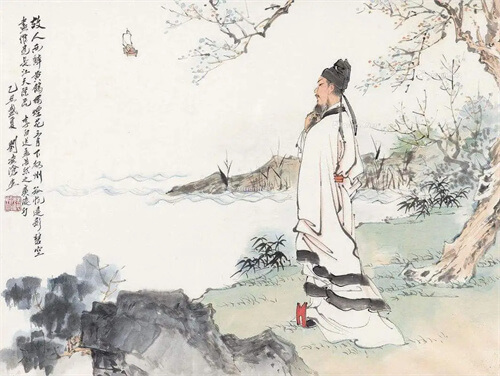赏析
《春晓》这首诗是诗人隐居在鹿门山时所做,意境十分优美。诗人抓住春天的早晨刚刚醒来时的一瞬间展开描写和联想,生动地表达了诗人对春天的热爱和怜惜之情。此诗没有采用直接叙写眼前春景的一般手法,而是通过“春晓”(春天早晨)自己一觉醒来后瞬间的听觉感受和联想,捕捉典型的春天气息,表达自己喜爱春天和怜惜春光的情感。
诗的前两句写诗人因春宵梦酣,天已大亮了还不知道,一觉醒来,听到的是屋外处处鸟儿的欢鸣。诗人惜墨如金,仅以一句“处处闻啼鸟”来表现充满活力的春晓景象。但人们由此可以知道就是这些鸟儿的欢鸣把懒睡中的诗人唤醒,可以想见此时屋外已是一片明媚的春光,可以体味到诗人对春天的赞美。
正是这可爱的春晓景象,使诗人很自然地转入诗的第三、四句的联想:昨夜我在朦胧中曾听到一阵风雨声,现在庭院里盛开的花儿到底被摇落了多少呢?联系诗的前两句,夜里这一阵风雨不是疾风暴雨,而当是轻风细雨,它把诗人送入香甜的梦乡,把清晨清洗得更加明丽,并不可恨。但是它毕竟要摇落春花,带走春光,因此一句“花落知多少”,又隐含着诗人对春光流逝的淡淡哀怨以及无限遐想。
宋人叶绍翁《游园不值》诗中的“春色满园关不住,一枝红杏出墙来”,是古今传诵的名句。其实,在写法上是与《春晓》有共同之处的。叶诗是通过视觉形象,由伸出墙外的一枝红杏,把人引入墙内、让人想象墙内;孟诗则是通过听觉形象,由阵阵春声把人引出屋外、让人想象屋外。只用淡淡的几笔,就写出了晴方好、雨亦奇的繁盛春意。两诗都表明,那盎然的春意,自是阻挡不住的,你看,它不是冲破了围墙屋壁,展现在你的眼前、萦回在你的耳际了吗?
施补华曰:“诗犹文也,忌直贵曲。”(《岘佣说诗》)这首小诗仅仅四行二十个字,写来却曲屈通幽,回环波折。首句破题,“春”字点明季节,写春眠的香甜。“不觉”是朦朦胧胧不知不觉。在这温暖的春夜中,诗人睡得真香,以至旭日临窗,才甜梦初醒。流露出诗人爱春的喜悦心情。次句写春景,春天早晨的鸟语。“处处”是指四面八方。鸟噪枝头,一派生机勃勃的景象。“闻啼鸟”即“闻鸟啼”,古诗为了押韵,词序作了适当的调整。三句转为写回忆,诗人追忆昨晚的潇潇春雨。末句又回到眼前,联想到春花被风吹雨打、落红遍地的景象,由喜春翻为惜春,诗人把爱春和惜春的情感寄托在对落花的叹息上。爱极而惜,惜春即是爱春──那潇潇春雨也引起了诗人对花木的担忧。时间的跳跃、阴晴的交替、感情的微妙变化,都很富有情趣,能给人带来无穷兴味。
《春晓》的语言平易浅近,自然天成,一点也看不出人工雕琢的痕迹。而言浅意浓,景真情真,就像是从诗人心灵深处流出的一股泉水,晶莹透澈,灌注着诗人的生命,跳动着诗人的脉搏。读之,如饮醇醪,不觉自醉。诗人情与境会,觅得大自然的真趣,大自然的神髓。“文章本天成,妙手偶得之”,这是最自然的诗篇,是天籁。▲
Appreciation
The poem “Spring Dawn” was written when the poet was living in seclusion on Mount Lumen, and it has a very beautiful mood. The poet seizes the moment of waking up in the spring morning to describe and associate with it, vividly expressing the poet’s love and pity for spring. This poem does not use the general technique of directly describing the spring scene in front of us, but captures the typical spring weather through the momentary auditory sensation and association after waking up at the “spring dawn” (spring morning), and expresses his feelings of loving spring and pitying the spring light.
The first two lines of the poem are about the poet not knowing that it was already dawn because he had been dreaming soundly during the spring night, and when he woke up, he heard the birds singing everywhere outside the house. The poet is so shy of ink that he only uses one line, “Hearing birds crying everywhere,” to express the vibrant scene of spring dawn. But from this, one can know that it is the birds’ joyful chirping that woke up the poet from his lazy sleep, and one can imagine that it is already a bright spring outside the house, and one can feel the poet’s praise for spring.
It is this lovely scene of spring dawn that makes the poet naturally move on to the third and fourth lines of the poem: last night I heard a wind and rain in the haze, how much of the flowers in bloom in the courtyard have been shaken off? The first two lines of the poem show that the storm was not a storm, but a light wind and rain, which sent the poet to a sweet dream and made the morning brighter, which is not hateful. But after all, it is going to shake off the spring flowers and take away the spring light. Therefore, the phrase “how many flowers have fallen” implies the poet’s faint sorrow and infinite reverie for the passing of spring light.
In the poem “The Garden is Worthless” by Ye Shaoweng, a Song poet, “The garden is full of spring colors, a red apricot comes out of the wall” is a famous line recited in ancient and modern times. In fact, it has something in common with “Spring Dawn” in terms of writing style. Ye’s poem is written with a visual image of a branch of red apricot sticking out of the wall, bringing people inside the wall and making them imagine the inside of the wall; Meng’s poem is written with an auditory image of a burst of spring sounds drawing people out of the house and making them imagine the outside of the house. With just a few light strokes, the poem depicts the exuberant spring feeling of sunshine and rain. Both poems show that the spring mood is unstoppable, and you can see that it has broken through the walls and walls of the house and is now in front of your eyes and between your ears.
Shi Fuhua said: “Poetry is like literature, avoid straight and expensive.” (This small poem is only four lines and twenty words, but it is written in a twisted and winding way. The first line of the poem is a break from the title, and the word “spring” indicates the season and describes the sweetness of spring sleep. The word “not aware” is a hazy and unconscious word. In this warm spring night, the poet slept so well that he woke up only when the rising sun approached his window. The poet’s joyful feeling of loving spring is revealed. The next line is about the spring scenery and the birds’ songs in the spring morning. The word “everywhere” refers to all directions. The birds are noisy on the branches, a vibrant scene. “The poem’s sequence has been adjusted to rhyme with the words. In the third line, the poet reminisces about the spring rain last night. In the last line, the poet returns to the scene in front of him, associating the spring flowers being beaten by the wind and rain and falling red everywhere. The poet’s love for spring and his pity for it are the same as his love for spring – the dashing spring rain also causes the poet to worry about the flowers and trees. The leap of time, the alternation of cloudy and sunny days, and the subtle changes of emotion are all very interesting and can bring endless interest to people.
The language of “Spring Dawn” is easy and shallow, natural, and not at all artificially crafted. It is like a spring flowing from the depths of the poet’s heart, crystal clear, filled with the poet’s life and beating with his pulse. Reading it, like drinking molasses, one does not feel drunk. The poet’s emotions and the situation will find the true interest of nature and the divine essence of nature. “The poem is the most natural poem, the heavenly music. ▲


















